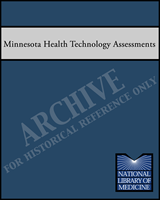NCBI Bookshelf. A service of the National Library of Medicine, National Institutes of Health.
Minnesota Health Technology Advisory Committee. Minnesota Health Technology Assessments [Internet]. St. Paul (MN): Minnesota Department of Health; 1995-2001.
This publication is provided for historical reference only and the information may be out of date.
Executive Summary
Acute myocardial infarction (AMI) results from the sudden obstruction of a coronary artery by a blood clot (thrombus). Thrombolytic therapy is a method of dissolving such blood clots and restoring blood flow to the heart. Tissue plasminogen activator (tPA) and streptokinase (SK) are the two common thrombolytics used in Minnesota. The approximate purchase price of tPA and SK to the provider are $2,300 and $300 per dose, respectively. The approximate difference in purchase price to the patient is $2,400.
Rationale
Several of the earlier large clinical trials have found no significant difference between tPA and SK in terms of clinical effectiveness. Smaller trials suggested that the method of administering tPA in those trials was not the most effective. In 1993 a large clinical trial (GUSTO) compared a new regimen for administering tPA (accelerated tPA) with SK and found tPA to be more clinically effective. The difference in the mortality rates experienced by patients treated with the two drugs was small (6.3% vs. 7.3%) but statistically significant. This technology was selected for evaluation because the small increment in clinical effectiveness associated with accelerated tPA (1%) appears to have a high incremental cost ($2,000 per patient). It was also selected due to the number of Minnesotans affected by AMI annually (approximately 12,000).
Conclusions
- Thrombolytic therapy saves lives.
- Thrombolytics are under-utilized. In Minnesota we estimate that there are approximately 12,000 hospital admissions for acute myocardial infarction annually. It is estimated that only 30% of these patients currently receive thrombolytic therapy.
- The benefit of thrombolytic therapy diminishes with time after symptom onset. Providers of health care should make every effort to administer thrombolytic therapy to appropriate patients without delay.
- Both streptokinase and tissue plasminogen activator are safe and effective thrombolytic agents.
- Available data appears to indicate that accelerated tissue plasminogen activator confers an additional survival benefit compared to streptokinase, especially for anterior infarct, or when thrombolytic therapy is initiated within four hours after symptom onset.
- Available data indicates an increased rate of stroke associated with the use of tPA; approximately 2.5 additional strokes per 1,000 patients. The cost associated with treating strokes and the impact on health outcome should be considered in comparing the cost of tPA to SK.
- Based on a $2,000 difference between the cost of tPA and streptokinase, using tPA would reduce mortality at a cost of approximately $200,000 per additional life saved or approximately $29,000 per life year saved (based on an incremental life expectancy of 11 years).
- Current estimates of the use of thrombolytics in Minnesota vary widely and Minnesota-specific data on the use of thrombolytics is limited. On the basis of the data currently available, it is estimated that using tPA as the thrombolytic of choice in Minnesota would save approximately 35 additional lives annually, when compared with streptokinase, at an additional total cost of approximately $7 million.
- Physicians should recognize that the cost of tPA is approximately seven times that of streptokinase, and hence, the use of tPA should be confined to patients who, in the treating physician's judgement, are most likely to benefit.
Implications
If patients are treated with thrombolytics within one hour of the onset of symptoms, their chances of survival are maximized. Counties, health regions, and public health officials may consider health education aimed at decreasing the time it takes a patient to recognize symptoms and get to the hospital.
If patients are treated with thrombolytics within 30 minutes of arrival in the emergency room (as recommended by the National Health Attack Alert Program), their chances of survival are also increased. Hospitals' emergency room personnel and emergency physicians are encouraged to streamline emergency room procedures with this goal in mind.
Integrated Service Networks may wish to develop standard protocols designed to assure the use of tPA for cases where it will be the most effective.
Other Issues/Considerations
- Minnesota-specific data on the use of thrombolytics is limited. More complete data would permit HTAC to draw more specific conclusions.
- Regional Coordinating Boards (RCBs) may wish to monitor how medical facilities and networks in their region are addressing the issues raised by this evaluation.
- The Practice Parameters Advisory Committee (PPAC) may wish to develop guidelines to assist physicians in determining which patients are most likely to benefit from tPA.
- As additional analysis of the GUSTO data becomes available, a re-evaluation of tPA may be warranted.
- Thrombolytic Therapy for Acute Myocardial Infarction - Minnesota Health Technolo...Thrombolytic Therapy for Acute Myocardial Infarction - Minnesota Health Technology Assessments
Your browsing activity is empty.
Activity recording is turned off.
See more...
